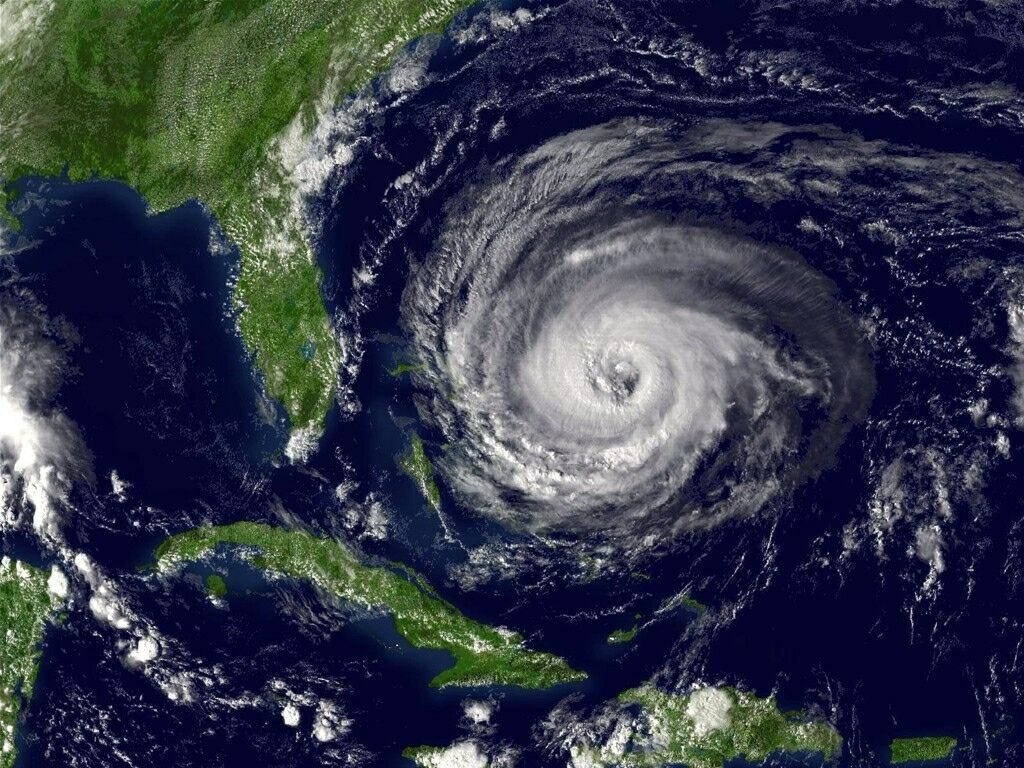Be Ready Florida! Even if your area hasn’t been hit with a major hurricane in years, don’t let this be the year you slack off on your hurricane preparation. Condon-Meek Insurance wants to help you prepare for a hurricane, so in the unfortunate event of hurricane damage, or evacuation – you are better prepared to handle what comes your way.
Print our Hurricane Preparedness Checklist and get started on your Emergency kit today.
Respect what hurricanes can do – and know what your insurance covers.
We’ve all seen the dramatic effect hurricanes can have – from both the initial wind and then the rain and floods that follow.
Your insurance policy should cover repair or rebuilding costs of covered losses. If you can’t live in your home, you will need Additional Living Expenses (ALE) covered. Review your policy for detailed coverage explanations.
You should review your insurance policies once a year to make sure you have enough coverage to rebuild based on current construction costs. We recommend you get a precise estimate and make sure you talk to your agent about your home’s unique features.
Flood damage from hurricanes isn’t covered by property insurance.
It’s important to know that home insurance does not cover flood damage from a hurricane. Your agent can help you purchase a flood insurance policy – please contact us today to discuss this.
Reduce potential damage before a hurricane hits.
- Install storm shutters
- Remove yard debris, like dead tree limbs, that could become flying objects.
- Have a safe place to park your cars or store your boat.
- Make sure you, your family or employees know how to shut off utilities.
- Back-up computer records and store them at least 50 miles off-site.
- Gather important papers, including inventory lists and insurance information, to take with you if you must evacuate.
Hurricane Tracking Charts
Download these blank tracking charts for Hurricane Season.
Why You Need a Weather Radio?
It’s very likely that you will lose power when a hurricane hits your area and if that’s the case then you want to make sure to have access to a source of information that isn’t reliant on power to work. Weather radios are designed to receive the NOAA Weather Radio service’s broadcast with weather status and updates. You will receive 24-7 weather information. Weather radio’s are also designed to respond to the FCC’s Emergency Alert System.
Check our our top picks for weather radios at our Amazon Store.
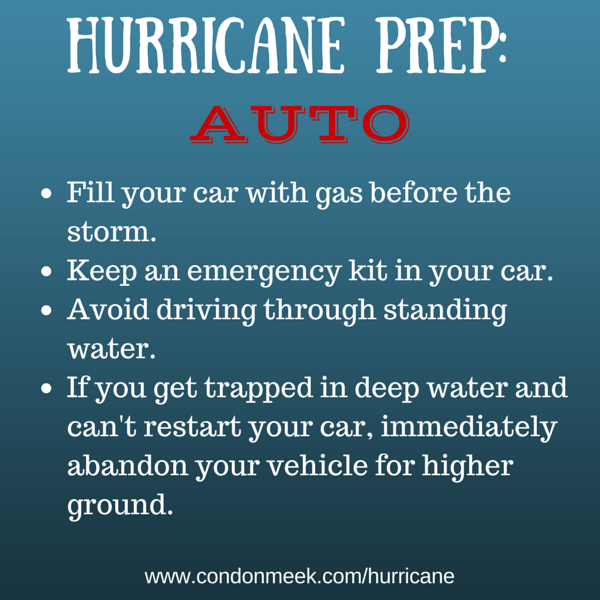
Hurricane Preparedness: Auto
Auto Safety in a Hurricane
- Make sure to fill your car with gasoline before the storm arrives. Plan ahead for longer lines at the pump.
- Keep an emergency kit stocked in your car in the event of a breakdown.
- If you decided to evacuate your area and leave your vehicle behind, make sure it is not left in a low-lying area that is prone to flooding.
- When you are evacuating or returning to your home following the storm, keep an eye out for standing water in parking lots and streets.
- Avoid driving through standing water. Most cars can be swept away by as little as 12 inches of moving water. Find an alternate route.
- If you find no other alternate route and must drive through standing water, do your best to estimate the depth of the water. Roadways can collapse under water.
- Drive slowly and steadily through the water.
- If your car stalls in the deep water, you may need to restart the engine to make it to safety but know that restarting your car may cause irreversible damage to your engine.
- If you are unable to restart your vehicle and you become trapped in rising water, IMMEDIATELY ABANDON THE VEHICLE FOR HIGHER GROUND. If you are unable to get out of the car, call 911 or get the attention of a passerby or someone on higher ground.
- Once you and your vehicle are out of deep water and are in a safe area, depress your brakes slowly several times to help dry them out.
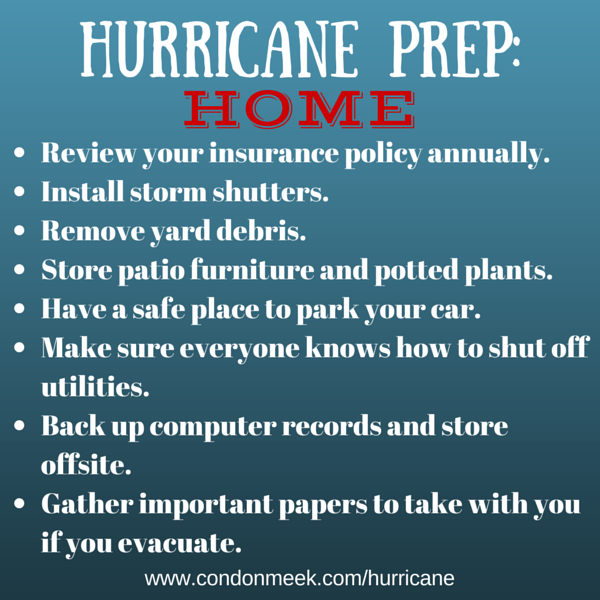
Hurricane Preparedness: Home
Before the Storm
Do not wait until a storm is approaching to review your insurance policy, you will be unable to make changes to your policy once a storm enters “the box” that carriers draw in the Gulf and Atlantic.
- Homeowner’s insurance typically covers the cost to repair common hurricane damage, including damage to roofs and walls, cars and your personal belongings. Review your policy with you agent so you know exactly what will be covered.
- If you can’t live in your home, your insurance may help pay for additional living expenses as provided in your policy. Review your policy for detailed coverage explanations.
- Review your insurance policy once a year to make sure you have enough coverage to rebuild based on current construction costs. Learn more about Market Cost vs. Cost to Rebuild.
- Work with an independent building contractor to get a precise estimate, and talk to your agent about your home’s unique features.
Steps to Reduce Hurricane Damage
- Install storm shutters.
- Remove yard debris, like dead tree limbs, that could become flying missiles.
- Store patio furniture and potted plants.
- Have a safe place to park your cars and/or store your boat. (read more about Hurricane Prep for boats below).
- Make sure you, your family, and/or your employees know how to shut off utilities.
- Back up computer records and store them at least 50 miles offsite.
- Gather important papers, including home inventory lists and insurance information to take with you if you must evacuate.
During a Hurricane
- Avoid elevators
- Stay inside and away from windows, skylights and glass doors.
- Know your county’s evacuation plan and, if asked to evacuate, do so immediately.
After a Hurricane
Severe winds from a hurricane can down electrical lines, telephone poles and tress. Heavy rain can cause water damage and flooding. If a hurricane has been through your neighborhood, be careful. Take some precautions by following these tips:
- Watch out for snakes and animals that may have taken refuge in your home.
- Don’t run a generator or barbecue grill indoors. Hazardous fumes and carbon monoxide poisoning can be deadly.
- Don’t leave candles or a fireplace unattended, and keep the area well ventilated.
- Watch out for broken glass, sharp objects and exposed electrical wires.
- Listen to the local radio for up-to-date information.
- If you evacuated, don’t return home until local authorities say it’s safe to do so.
- Check gas, electrical and sewage systems, and your chimney.
- If gas is leaking, turn it off at the main shut-off valve, leave the building immediately, and call a professional for service.
- Stay our of your home if it is severely damaged.
Call Us
Once it is safe to do so call us at 1-800-221-1964.
Be ready with the following information:
- Where is the damaged property?
- How extensive is the damage?
- Are temporary repairs needed?
- If the authorities were contact, which department responded and what is the report number?
- What is your current contact information, if different than what we have on file?
- If you are able to, take photos of the damage. The photos can be very helpful during the claims process.
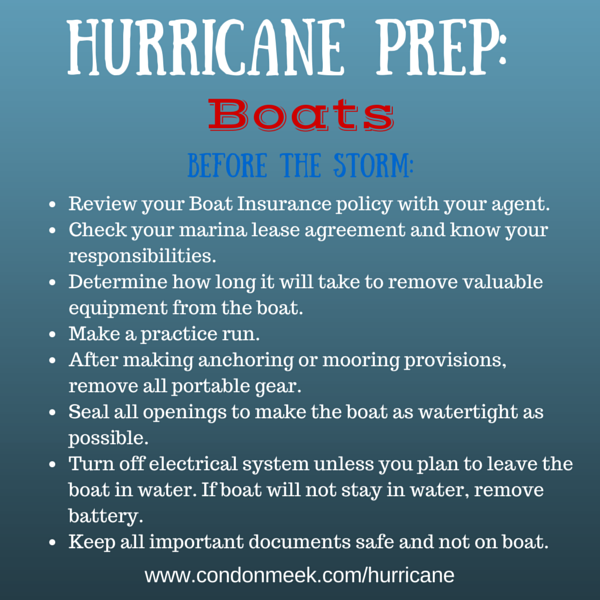
Hurricane Preparedness: Boat
The key to protecting your boat from hurricanes or any severe weather is planning, preparation and timely action. Most of the work is done BEFORE the storm. Typically, you have from 12 to 24 hours to take action after bad weather is predicted or a hurricane warning is issued but the key is to HAVE A PLAN ahead of time.
Before the Storm
- Review your Boat Insurance policy with your agent to make sure you have proper coverage.
- Make a list of the equipment and supplies you will need to carry out your plan.
- Arrange for a reliable person to carry out your plan if you are out of town during a storm.
- Check your marina or storage area’s lease or rental agreement and know your responsibilities and liabilities as well as the marina or storage area’s responsibilities.
- Determine how long it will take to remove valuable equipment from the boat so you will have an accurate estimate of time and effort involved.
- Make a practice run to check accessibility, depth of water, bridges, location of aids/or obstructions to navigation and locations to secure lines or drop anchors. Check to see if drawbridges will be open during evacuation time.
- After you have made anchoring or mooring provisions, remove all portable equipment: canvas, sails, dinghies, radios, cushions, Bimini tops etc. Tie down everything you cannot remove.
- Seal all openings to make the boat as watertight as possible.
- Turn off electrical system unless you plan to leave the boat in the water. If the boat is not going to remain in water, remove the battery to eliminate the risk of fire.
- If time allows, remove your boat from the threatened area or take your boat to a previously identified hurricane refuge.
- Keep all documents, including insurance policies, a recent photo or video of the boat, registration, equipment inventory, lease agreement and telephone numbers of the harbor master, coast guard, insurance agent, national weather service, etc. Store these documents somewhere safe, other than your boat.
For Smaller, Lightweight Boats
- Determine what you need to do to load and haul your boat to a safer area.
- Check the condition of your trailer tires, bearings and axle.
- Once at a safe place, lash your boat to the trailer and place blocks between the frame members and the axle inside wash wheel. Owners of lightweight boats may wish to consider letting out about half the air in each tire, then filling the boat one-third full of water to help hold it down. The blocks will prevent damage to the springs from the additional weight of the water. Consult with the manufacturer for the best procedure for securing your lightweight boat.
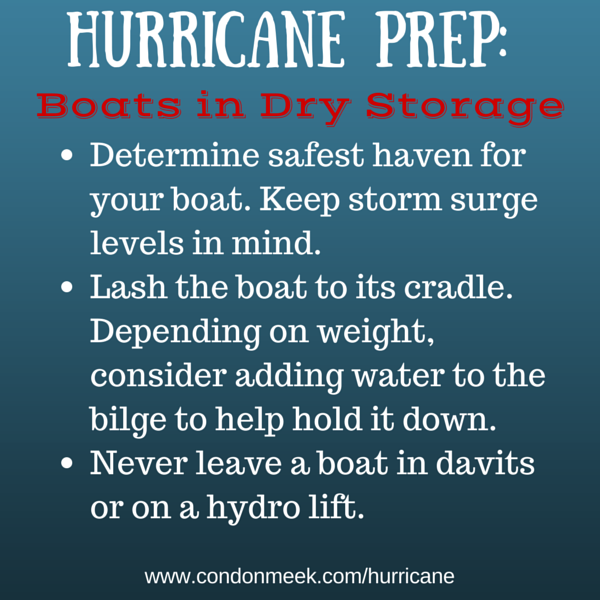
For Boats in Dry Storage
- Determine the safest obtainable haven for your boat and make arrangements to move your boat there. When selecting a safe location, be sure to consider whether storm surge could rise into that area.
- Wherever you choose to leave your boat for the duration of the storm, lash the boat to its cradle with heavy lines. Based on the weight of the boat, consider adding water to the bilge to help hold it down.
- Never leave a boat in davits or on a hydro-lift.
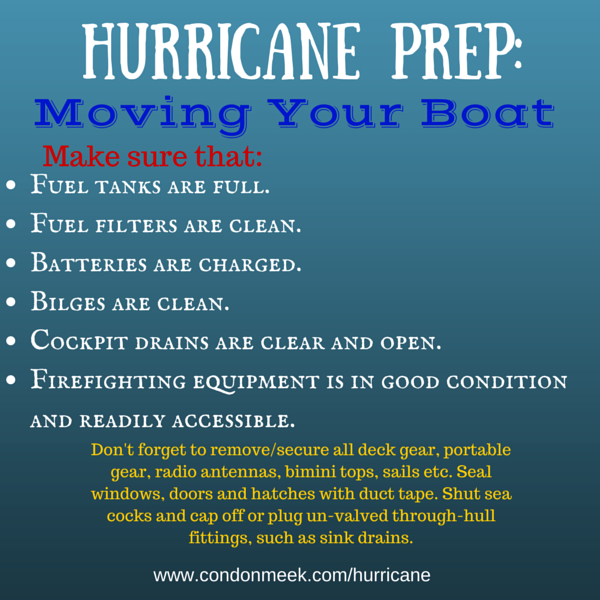
Moving Your Watercraft
If your plan calls for moving your watercraft, try to move it at least 48 to 72 hours before the hurricane or storm is estimated to strike the area. This may even be before a hurricane watch is issued.
Make sure that:
•Fuel tanks are full.
•Fuel filters are clean.
•Batteries are charged.
•Bilges are clean.
•Cockpit drains are clear and open.
•Firefighting equipment is in good condition, in place and readily accessible.
Remove and/or secure all deck gear, portable gear, radio antennas, outriggers, fighting chairs, deck boxes, bimini tops and side canvas/curtains, sails, booms, dorades, extra halyards, canister rafts, and dinghies. Make sure that you secure all hatches, ports, doors, lazarettes and sailboat rudders. The dinghy may be required to take lines ashore.
Enhance the watertight integrity of your boat, both above and below the water line. Seal windows, doors and hatches, if necessary, with duct tape. Shut sea cocks and cap off or plug unvalved through-hull fittings, such as sink drains.
If your watercraft is moored at a dock on a canal, river, or in a marina near the ocean, it is possible that with an additional 5-10 foot or greater storm surge the vessel could take a beating against a dock or even impale itself on the pilings. The best offshore mooring location for a vessel to ride out a storm is in the center of a canal or narrow river where at least doubled mooring lines can be secured to both shores, port and starboard, fore and aft. Do not raft vessels together at moorings or docks, especially if larger and smaller vessels are involved. The probability of damage to the vessels is greater than if they are moored separately.
If the vessel must remain dockside at a private dock or marina, heavy duty fender boards (2×6) should be installed on a bare wood center piling to prevent damage. Lines should be doubled and even tripled where necessary to hold a vessel in the center of a berth or off seawall or dock pilings. Preventers should be installed at the top of the pilings so lines cannot slip off the top. Note that nylon line will stretch five to ten percent of its length.
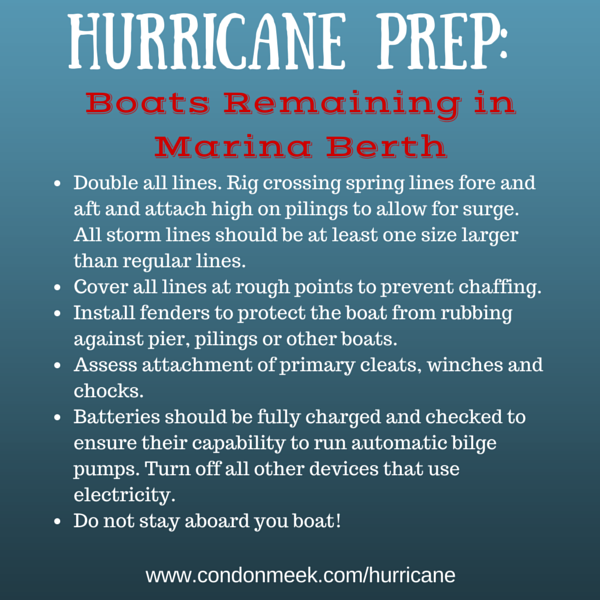
For Boats Remaining in Marina Berth
•Double all lines. Rig crossing spring lines fore and aft and attach high on pilings to allow for tidal rise or surge. Make sure lines will not slip off pilings. Inspect the pilings and choose those that seem the strongest and tallest. All storm lines used should be at least one size larger than regular lines.
•Cover all lines at rough points to prevent chafing. Install fenders to protect the boat from rubbing against the pier, pilings and other boats.
•Assess the attachment of primary cleats, winches and chocks. These should have substantial back plates and adequately sized stainless steel bolts.
•Batteries should be fully charged and checked to ensure their capability to run automatic bilge pumps for the duration of the storm. Turn off all other devices that use electricity.
•Do not stay aboard your boat!
Hurricane Damage?
If you have storm damage, call us as soon as possible at 1-800-221-1964.

IMPORTANT DISCLAIMER: This information brought to you by Condon-Meek Insurance, Progressive and SafeCo is for informational purposes only, please contact your agent directly to speak with them regarding any coverages or changes to your specific policies.

